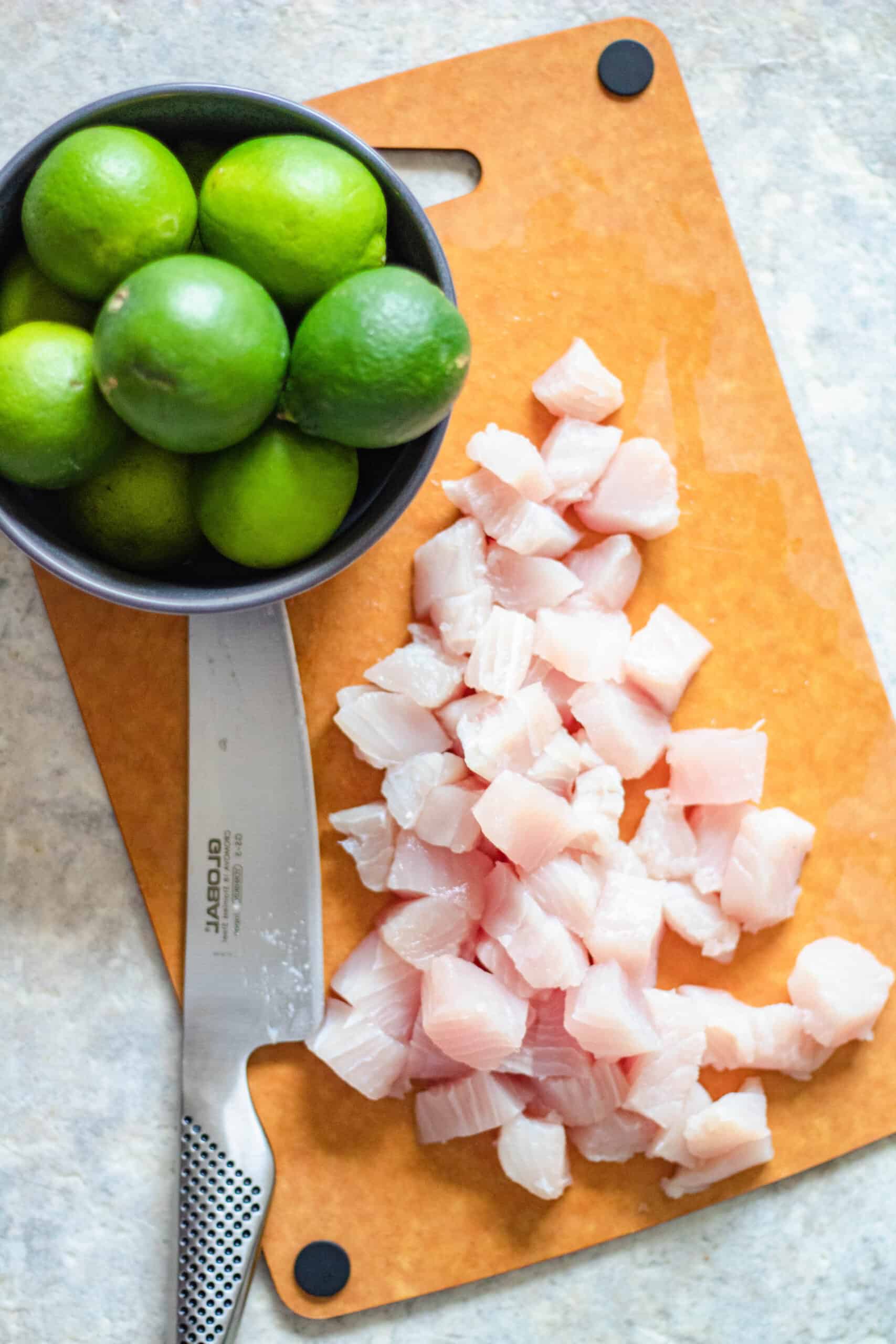Ceviche is a delicious appetizer or main dish made with raw seafood that is cooked by acid in lemon or lime juice. This unique cooking method requires some patience and a little bit of know-how. To determine just how long your ceviche needs to process, follow these tips!
Ceviche is a flavorful South American seafood dish, full of citrus, tomato, cilantro, and of course, fish. It is essentially pico de gallo with the added flavor and texture of seafood, and it is the perfect, fresh appetizer.
When the raw fish is marinated in citrus, the citric acid in the citrus juice has a strange effect on the protein of the fish. It causes a chemical process called the “denaturation of the proteins”, eventually turning the flesh opaque and flaky, like perfectly cooked fish.
The level of acidity in your citrus juice, the type of fish used, and the size of the fish pieces can all change the amount of time this process takes. But when done correctly, it can leave you with fish that is flaky, flavorful, and amazing!
It is very important when making ceviche to use only the freshest seafood possible. Using acid, rather than heat, to cook your fish will not kill all the bacteria or microorganisms that could be present in raw fish, though it may slow them.
This process should be safe to eat but you should still use caution and only high-quality, fresh ingredients.
As a general rule, when choosing fish for ceviche it may be a good idea to use frozen pieces of fish unless you can determine the exact freshness of the fresh fish. Often fish are frozen as soon as they are caught, making frozen fish safer than the “fresh” fish.
Ceviche is an ancient dish that has been enjoyed for thousands of years in Latin America. It is believed that ceviche originated in Peru with the Moche civilization.
At the time they did not have lemons or limes but likely prepared chunks of raw fish with passionfruit called tumbo or with chicha, a beverage made with fermented corn. It’s also possible the fish was eaten raw.
Today’s ceviche was inspired by the Spanish who brought lime and cilantro to South America. The lime was a perfect replacement for tumbo and chicha.
Ceviche has also been influenced by Japanese cuisine. The Japanese are familiar with using raw fish for things like sushi and have shown chefs that it is unnecessary to let ceviche cook for hours. They prepare thin slices of raw fish and then pour the citrus over the top and enjoy right away, which some people now prefer.
I have a recipe for ceviche inspired by Fijian cuisine. In this ceviche recipe, the mahi mahi is cooked with lime juice and is then served with coconut milk and diced vegetables.

What Fish Should Be Used in Ceviche?

Choosing the right fish is important for flavor and for safety. Some fish are more prone to bacteria that cause food poisoning than others.
Because ceviche is considered a raw fish dish, you could use any high-quality fish you might typically enjoy raw on sushi like tuna or salmon, or really any white fish with firm flesh like sea bass, snapper, and tilapia.
It is not recommended to use cod or halibut because they are prone to certain food-borne illnesses that would not be cooked off.
Each region and chef has their own preferred fish or different types of seafood to use. As long as it is high quality and fresh, it is probably safe.
How Long Does Ceviche Take to Cook?
The prep time for ceviche is ultimately a matter of preference. Like a good steak, the cooking time can have a dramatic impact on the flavor and texture of the meat.
For rare meat, ceviche only needs to cook in the acidic marinade for 15 to 20 minutes. Thirty minutes to one hour in the acidic juices are considered medium and for well-done fish, you should let it marinate for up to four hours.
It is possible to overcook your fish, even using this cooking method so be sure and test your fish before serving your finished ceviche. If your fish has marinated for more than two hours some chefs describe it as “pickled.” Fish may fall apart and feel chalky while shellfish may feel rubbery and tough.
If you do not know your preference, it is easy to try it out! Cut up some fish into small pieces and let it sit in your citrus marinade. Taste a piece every five to ten minutes. Take note of the flavor and the texture and how both change over time.
Many people also use shrimp or scallops in ceviche. You can cook your shellfish using the same method. Or you might choose to parboil your shrimp first as this is the safest option, especially for pregnant women and people with compromised immune systems. There is no need to cook your shellfish all the way through as it will continue to cook in the citrus.
Boiled shrimp should marinate for about 15 minutes while fresh raw shrimp may take a couple of hours to fully cook.
CEVICHE! Super easy ceviche de pescado (fish ceviche) for summer!
FAQ
How long does it take for ceviche to be ready to eat?
How long should ceviche be marinated?
Can you overcook ceviche?
Should ceviche sit overnight?
